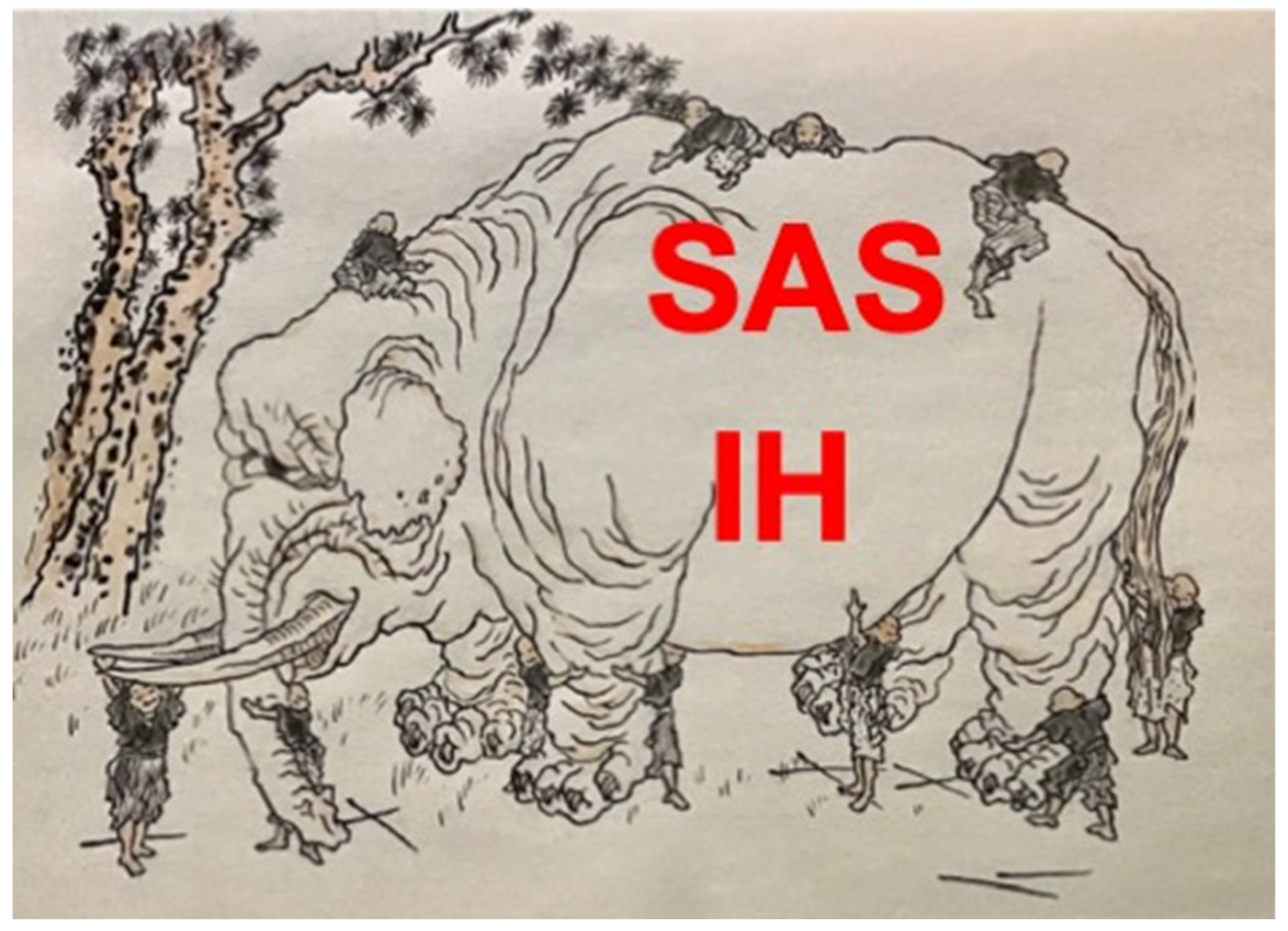Editorial to Special Issue “Sleep Apnea and Intermittent Hypoxia 2.0”
Funding
Conflicts of Interest
References
- Benjafield, A.V.; Ayas, N.T.; Eastwood, P.R.; Heinzer, R.; Ip, M.S.M.; Morrell, M.H.; Nunez, C.M.; Patel, S.R.; Penzel, T.; Pépin, J.-L.D.; et al. Estimation of the global prevalence and burden of obstructive sleep apnoes: A literature-based analysis. Lancet Respir. Med. 2019, 7, 687–698. [Google Scholar] [CrossRef] [Green Version]
- Ahmad, M.; Makati, D.; Akbar, S. Review of and updates on hypertension in obstructive sleep apnea. Int. J. Hypertens. 2017, 2017, 1848375. [Google Scholar] [CrossRef] [PubMed]
- Martinez, C.-A.; Kerr, B.; Jin, C.; Cistulli, P.A.; Cook, K.M. Obstructive sleep apnea activates HIF-1 in a hypoxia dose-dependent manner in HCT116 colorectal carcinoma cells. Int. J. Mol. Sci. 2019, 20, 445. [Google Scholar] [CrossRef] [PubMed] [Green Version]
- Kheirandish-Gozal, L.; Gozal, D. Obstructive sleep apnea and inflammation: Proof of concept based on two illustrative cytokines. Int. J. Mol. Sci. 2019, 20, 459. [Google Scholar] [CrossRef] [Green Version]
- Shobatake, R.; Itaya-Hironaka, A.; Yamauchi, A.; Makino, M.; Sakuramoto-Tsuchida, S.; Uchiyama, T.; Ota, H.; Takahashi, N.; Ueno, S.; Sugie, K.; et al. Intermittent hypoxia up-regulates gene expressions of peptide YY (PYY), glucagon-like peptide-1 (GLP-1), and neurotensin (NTS) in enteroendocrine cells. Int. J. Mol. Sci. 2019, 20, 1849. [Google Scholar] [CrossRef] [Green Version]
- Uchiyama, T.; Itaya-Hironaka, A.; Yamauchi, A.; Makino, M.; Sakuramoto-Tsuchida, S.; Shobatake, R.; Ota, H.; Takeda, M.; Ohbayashi, C.; Takasawa, S. Intermittent hypoxia Up-regulates CCL2, RETN, and TNFα mRNAs in adipocytes via down-regulation of miR-452. Int. J. Mol. Sci. 2019, 20, 1960. [Google Scholar] [CrossRef] [Green Version]
- Kyotani, Y.; Takasawa, S.; Yoshizumi, M. Proliferative pathways of vascular smooth muscle cells in response to intermittent hypoxia. Int. J. Mol. Sci. 2019, 20, 2706. [Google Scholar] [CrossRef] [Green Version]
- Chen, Y.-C.; Hsu, P.-Y.; Hsiao, C.-C.; Lin, M.-C. Epigenetics: A potential mechanism involved in the pathogenesis of various adverse consequences of obstructive sleep apnea. Int. J. Mol. Sci. 2019, 20, 2937. [Google Scholar] [CrossRef] [Green Version]
- Sřámek, J.; Němcová-Fürstová, V.; Polák, J.; Kovář, J. Hypoxia modulates effects of fatty acids on NES2Y human pancreatic β-cells. Int. J. Mol. Sci. 2019, 20, 3441. [Google Scholar] [CrossRef] [Green Version]
- Ota, H.; Fujita, Y.; Yamauchi, M.; Muro, S.; Kimura, H.; Takasawa, S. Relationship between intermittent hypoxia and Type 2 diabetes in sleep apnea syndrome. Int. J. Mol. Sci. 2019, 20, 4756. [Google Scholar] [CrossRef] [Green Version]
- Salman, L.A.; Shulman, R.; Cohen, J.B. Obstructive sleep apnea, hypertension, and cardiovascular risk: Epidemiology, pathophysiology, and management. Curr. Cardiol. Rep. 2020, 22, 6. [Google Scholar] [CrossRef]
- Takasawa, S. CD38-cyclic ADP-ribose signal system in physiology, biochemistry and pathophysiology. Int. J. Mol. Sci. 2022, 23, 4306. [Google Scholar] [CrossRef]
- Takeda, Y.; Itaya-Hironaka, A.; Yamauchi, A.; Makino, M.; Sakuramoto-Tsuchida, S.; Ota, H.; Kawaguchi, R.; Takasawa, S. Intermittent hypoxia upregulates the Renin and Cd38 mRNAs in renin-producing cells via the downregulation of miR203. Int. J. Mol. Sci. 2021, 22, 10127. [Google Scholar] [CrossRef]
- Baran, R.; Grimm, D.; Infanger, M.; Wehland, M. The effect of contimuous positive airway pressure therapy on obstructive sleep apnea-related hypertension. Int. J. Mol. Sci. 2021, 22, 2300. [Google Scholar] [CrossRef]
- Mochol, J.; Gawrys, J.; Gajecki, D.; Szahidewicz-Krupska, E.; Martynowicz, H. Cardiovascular disorders triggered by obstructive sleep apnea—A focus on endothelium and blood components. Int. J. Mol. Sci. 2021, 22, 5139. [Google Scholar] [CrossRef]
- Chuang, L.-P.; Wu, H.-P.; Lee, L.-A.; Chiu, L.-C.; Lin, S.-W.; Hu, H.-C.; Kao, K.-C.; Chen, N.-H.; Tsai, J.-W.; Su Pang, J.-H. Elevated monocytic interleukin-8 expression under intermittent hypoxia condition and in obstructive sleep apnea patients. Int. J. Mol. Sci. 2021, 22, 11396. [Google Scholar] [CrossRef]
- Uchiyama, T.; Ota, H.; Ohbayashi, C.; Takasawa, S. Effects of intermittent hypoxia on cytokine expression involved in insulin resistance. Int. J. Mol. Sci. 2021, 22, 12898. [Google Scholar] [CrossRef]
- Shobatake, R.; Ota, H.; Takahashi, N.; Ueno, S.; Sugie, K.; Takasawa, S. Anorexigenic effects of intermittent hypoxia on the gut—brain axis in sleep apnea syndrome. Int. J. Mol. Sci. 2022, 23, 364. [Google Scholar] [CrossRef]
- Turkiewicz, S.; Ditmer, M.; Sochal, M.; Bialasiewicz, P.; Strzelecki, D. Obstructive sleep apnea as an acceleration trigger of cellular senescence processes through telomere shortening. Int. J. Mol. Sci. 2021, 22, 12536. [Google Scholar] [CrossRef]
- Lin, C.M.; Davidson, T.M.; Ancoli-Israel, S. Gender differences of obstructive sleep apnea and treatment implications. Sleep Med. Rev. 2008, 12, 481–496. [Google Scholar] [CrossRef] [Green Version]
- Bonsignore, M.R.; Saaresrata, T.; Riha, R.L. Sex differences in obstructive sleep apnea. Eur. Respir. Rev. 2019, 28, 190030. [Google Scholar] [CrossRef]

Publisher’s Note: MDPI stays neutral with regard to jurisdictional claims in published maps and institutional affiliations. |
© 2022 by the author. Licensee MDPI, Basel, Switzerland. This article is an open access article distributed under the terms and conditions of the Creative Commons Attribution (CC BY) license (https://creativecommons.org/licenses/by/4.0/).
Share and Cite
Takasawa, S. Editorial to Special Issue “Sleep Apnea and Intermittent Hypoxia 2.0”. Int. J. Mol. Sci. 2022, 23, 5299. https://doi.org/10.3390/ijms23105299
Takasawa S. Editorial to Special Issue “Sleep Apnea and Intermittent Hypoxia 2.0”. International Journal of Molecular Sciences. 2022; 23(10):5299. https://doi.org/10.3390/ijms23105299
Chicago/Turabian StyleTakasawa, Shin. 2022. "Editorial to Special Issue “Sleep Apnea and Intermittent Hypoxia 2.0”" International Journal of Molecular Sciences 23, no. 10: 5299. https://doi.org/10.3390/ijms23105299




